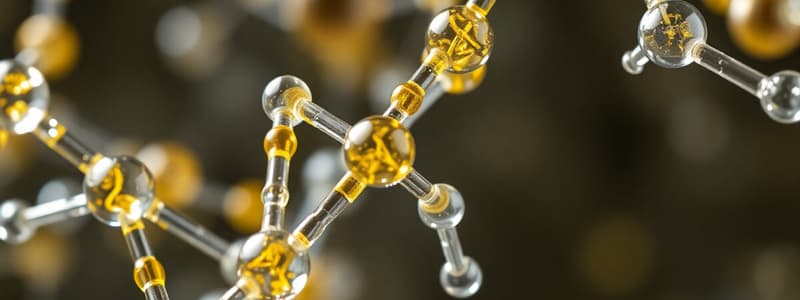Podcast
Questions and Answers
What is a common example of a natural polymer?
What is a common example of a natural polymer?
- Polypropylene
- Polystyrene
- Polyethylene
- Silk (correct)
Polymerization is a process that breaks down large molecules into smaller units.
Polymerization is a process that breaks down large molecules into smaller units.
False (B)
What are the two main types of polymerization?
What are the two main types of polymerization?
Chain-reaction Polymerization and Step-Reaction Polymerization
Ethylene polymerizes to form __________.
Ethylene polymerizes to form __________.
Match the following monomers with their corresponding polymers:
Match the following monomers with their corresponding polymers:
What is the relationship between stress and strain within the proportional limit?
What is the relationship between stress and strain within the proportional limit?
The elastic limit is the point beyond which a material returns to its original shape after the load is removed.
The elastic limit is the point beyond which a material returns to its original shape after the load is removed.
What is the term used for the maximum strength indicated on the stress-strain diagram?
What is the term used for the maximum strength indicated on the stress-strain diagram?
The region in the stress-strain diagram from O to P is called the ______.
The region in the stress-strain diagram from O to P is called the ______.
Match the following terms with their definitions:
Match the following terms with their definitions:
Which of the following materials is NOT an example of a metallic crystal structure?
Which of the following materials is NOT an example of a metallic crystal structure?
The hexagonal closed-pack (HCP) structure has 8 atoms per unit cell.
The hexagonal closed-pack (HCP) structure has 8 atoms per unit cell.
What is the relationship between cube edge length 'a' and atomic radius 'R' in a face-centered cubic (FCC) structure?
What is the relationship between cube edge length 'a' and atomic radius 'R' in a face-centered cubic (FCC) structure?
In crystallographic notation, a direction is specified as [____].
In crystallographic notation, a direction is specified as [____].
Match the following metallic elements with their respective crystallographic structures:
Match the following metallic elements with their respective crystallographic structures:
What type of molecular arrangement does a crystalline polymer have?
What type of molecular arrangement does a crystalline polymer have?
A polymer with lower crystallinity tends to have reduced clarity.
A polymer with lower crystallinity tends to have reduced clarity.
List one application of nanomaterials.
List one application of nanomaterials.
Nanomaterials are typically sized between ______ nanometers.
Nanomaterials are typically sized between ______ nanometers.
Match the following manufacturing approaches with their characteristics:
Match the following manufacturing approaches with their characteristics:
Which of the following properties can affect the solubility of nanomaterials?
Which of the following properties can affect the solubility of nanomaterials?
Viscoelasticity refers to materials that exhibit only viscous characteristics.
Viscoelasticity refers to materials that exhibit only viscous characteristics.
Name a physicist who contributed a concept related to nanotechnology.
Name a physicist who contributed a concept related to nanotechnology.
What is the main purpose of cold working metal?
What is the main purpose of cold working metal?
Permanent mold casting can be reused for multiple casts.
Permanent mold casting can be reused for multiple casts.
What process involves treating powdered metals with pressure and heat to form shapes?
What process involves treating powdered metals with pressure and heat to form shapes?
In powder metallurgy, metal powder is compacted and heated to cause the particles to bond into a __________.
In powder metallurgy, metal powder is compacted and heated to cause the particles to bond into a __________.
Match the following metal manufacturing processes with their characteristics:
Match the following metal manufacturing processes with their characteristics:
Which manufacturing process is NOT suitable for high-strength applications?
Which manufacturing process is NOT suitable for high-strength applications?
Deformation processes include only bending and rolling.
Deformation processes include only bending and rolling.
Name one advantage of using metal forming over casting.
Name one advantage of using metal forming over casting.
Which of the following is a method specifically for depositing one-atom-thick layers on a surface?
Which of the following is a method specifically for depositing one-atom-thick layers on a surface?
Self-assembly refers to components that require external direction to form an ordered structure.
Self-assembly refers to components that require external direction to form an ordered structure.
What is the main purpose of roll-to-roll processing in nanomaterial manufacturing?
What is the main purpose of roll-to-roll processing in nanomaterial manufacturing?
The process of creating nanoscale features by 'stamping' them onto a surface is known as __________.
The process of creating nanoscale features by 'stamping' them onto a surface is known as __________.
Match the manufacturing processes of nanomaterials to their descriptions:
Match the manufacturing processes of nanomaterials to their descriptions:
Which of the following potential effects of nanomaterials has been noted in relation to health?
Which of the following potential effects of nanomaterials has been noted in relation to health?
Airborne nanomaterials only affect the lungs and have no impact on the heart.
Airborne nanomaterials only affect the lungs and have no impact on the heart.
What is a noted risk of increased use of nanomaterials in the environment?
What is a noted risk of increased use of nanomaterials in the environment?
Flashcards
Hexagonal Closed-Pack (HCP)
Hexagonal Closed-Pack (HCP)
A crystal structure where atoms are arranged in a hexagonal pattern, with a top and bottom plane of 7 atoms forming a regular hexagon around a central atom, and a half-hexagon of 3 atoms in between.
Crystallographic direction
Crystallographic direction
A line or vector in a crystal structure, described by its coordinates (x, y, z).
Determining a crystallographic direction
Determining a crystallographic direction
The process of finding the coordinates of a crystallographic direction by calculating the difference between the coordinates of two points on the line (Head - Tail) or by finding the projection lengths on the x, y, and z axes.
FCC structure's edge length and atomic radius relationship
FCC structure's edge length and atomic radius relationship
Signup and view all the flashcards
HCP unit cell parameters 'a' and 'c'
HCP unit cell parameters 'a' and 'c'
Signup and view all the flashcards
Cold Working
Cold Working
Signup and view all the flashcards
Casting
Casting
Signup and view all the flashcards
Powder Processing
Powder Processing
Signup and view all the flashcards
Forming
Forming
Signup and view all the flashcards
Polymer
Polymer
Signup and view all the flashcards
Monomer
Monomer
Signup and view all the flashcards
Polymerization
Polymerization
Signup and view all the flashcards
Addition Polymerization
Addition Polymerization
Signup and view all the flashcards
Condensation Polymerization
Condensation Polymerization
Signup and view all the flashcards
Elastic Limit
Elastic Limit
Signup and view all the flashcards
Proportional Limit (Hooke's Law)
Proportional Limit (Hooke's Law)
Signup and view all the flashcards
Ultimate Strength
Ultimate Strength
Signup and view all the flashcards
Yield Point
Yield Point
Signup and view all the flashcards
Plastic Range
Plastic Range
Signup and view all the flashcards
Chemical Vapor Deposition
Chemical Vapor Deposition
Signup and view all the flashcards
Molecular Beam Epitaxy
Molecular Beam Epitaxy
Signup and view all the flashcards
Atomic Layer Epitaxy
Atomic Layer Epitaxy
Signup and view all the flashcards
Dip Pen Lithography
Dip Pen Lithography
Signup and view all the flashcards
Nanoimprint Lithography
Nanoimprint Lithography
Signup and view all the flashcards
Roll-to-Roll Processing
Roll-to-Roll Processing
Signup and view all the flashcards
Self-Assembly
Self-Assembly
Signup and view all the flashcards
Health Effects of Nanomaterials
Health Effects of Nanomaterials
Signup and view all the flashcards
Crystallinity
Crystallinity
Signup and view all the flashcards
Molecular Weight Distribution
Molecular Weight Distribution
Signup and view all the flashcards
Viscoelasticity
Viscoelasticity
Signup and view all the flashcards
Nanomaterials
Nanomaterials
Signup and view all the flashcards
Nanotechnology
Nanotechnology
Signup and view all the flashcards
Top-down nanomaterial manufacturing
Top-down nanomaterial manufacturing
Signup and view all the flashcards
Bottom-up nanomaterial manufacturing
Bottom-up nanomaterial manufacturing
Signup and view all the flashcards
Physical properties of nanomaterials
Physical properties of nanomaterials
Signup and view all the flashcards
Study Notes
Introduction to Chemistry of Engineering Materials
- Engineering materials are crucial for everyday life and survival.
- Gold was the first metal used, followed by copper.
- Material science, engineering materials, and materials engineering are scientific areas studying materials.
Basic Concepts of Crystal Structure
- Crystalline solids have a specific structure depending on how atoms, ions, or molecules are arranged.
- A space lattice is a periodic arrangement of points in three-dimensional space.
- A lattice point represents an atom.
- The lattice array is the pattern of lattice points.
- The lattice space is the space covered by the lattice points.
- A unit cell is a small group of atoms that repeats throughout the crystal structure.
- A unit cell can be defined as a fundamental structural unit that repeats throughout the crystal structure, it is a small repeating part of the larger crystal, and it contains all the structural information of the larger crystal structure.
Lattice Parameters
- Lattice parameters are the lengths (a, b, c) and angles (α, β, γ) that define the unit cell.
- Typically measured in angstroms (Å) or nanometers (nm).
- Seven crystal systems can be defined based on these parameters.
Basic Types of Crystal Systems
- Cubic: a = b = c; α = β = γ = 90°
- Hexagonal: a = b ≠ c; α = β = 90°, γ = 120°
- Tetragonal: a = b ≠ c; α = β = γ = 90°
- Rhombohedral (Trigonal): a = b = c; α = β = γ ≠ 90°
- Orthorhombic: a ≠ b ≠ c; α = β = γ = 90°
- Monoclinic: a ≠ b ≠ c; α = γ = 90° ≠ β
- Triclinic: a ≠ b ≠ c; α ≠ β ≠ γ ≠ 90°
Bravais Lattices
- Fourteen types of crystal systems with different centering properties.
- Types of Centering:
- Face-centered
- Body-centered
- Base-centered
Metallic Crystal Structures
- Simple Cubic (SC): Atoms located at the corners of a cube. Contains one atom per unit cell. Packing density is relatively low.
- Body-Centered Cubic (BCC): Atoms at the corners and the center of the cube. Contains two atoms per unit cell. Atoms touch along cube diagonals.
- Face-Centered Cubic (FCC): Atoms at the corners and the center of each face of the cube. Contains four atoms per unit cell. Atoms touch along face diagonals.
- Hexagonal Close-Packed (HCP): Atoms arranged in hexagonal layers with a center plane between them containing half-hexagon shaped atoms. Contains six atoms per unit cell.
Crystallographic Directions
- Directions in a crystal are defined by coordinates (x, y, z), relative to the unit cell.
- Notation: [uvw] where u, v, and w are integers.
- Directions are defined by specifying the coordinates (x, y, z) of a point on a vector (Pxyz) passing through the origin.
Properties of Crystals
- Atomic Packing Factor (APF): Ratio of volume of atoms to the volume of the unit cell (e.g., SC = 0.52, FCC = 0.74, BCC = 0.68).
- Planar Density (PD): Density of atomic packing on a particular plane.
- PD = (number of atoms on a plane) / (area of plane).
- Linear Density (LD): Number of atoms per unit length along a particular direction.
- LD = (number of atoms on direction vector) / (length of direction vector).
Metals
- Employed for various engineering purposes.
- Iron is the most popular metal in engineering.
- All metals have a crystalline structure.
Alloy
- Mixture or compound of two or more elements, at least one of which is metallic.
- Alloying enhances properties like strength and hardness.
- Classified into solid solution and intermediate phase.
Solid Solution
- One element dissolved in another to form a single-phase structure.
- Solvent or base element is metallic; dissolved element can be metallic or non-metallic.
- Types of solid solutions:
- Substitutional: atoms of the solvent element are replaced in its unit cell by the dissolved element.
- Interstitial: atoms of the dissolving element fit into vacant spaces between the base metal atoms.
Intermediate Phases
- When the amount of dissolving element exceeds the solid solubility limit of the base metal, a second phase forms.
- The phases have intermediate compositions and different structures than the pure elements.
Importance of Metals
- High stiffness and strength (alloyable).
- Toughness (ability to absorb energy).
- Good electrical and thermal conductivity.
- Competitive cost.
Metals Used in Manufacturing Process
- Cast metal: starting form is a casting.
- Wrought metal: metal has been worked.
- Powdered metal: starting form is very small powders.
Classification of Metals
- Ferrous metals: contain iron as a main constituent (e.g., cast iron, wrought iron, steel).
- Non-ferrous metals: do not contain iron (e.g., aluminum, copper, tin, zinc, lead).
Ferrous Metals
Sub-categories:
-
Cast iron (CI): Higher carbon content (2-4.23%). Hardened by cooling, but not temperable. Types of cast iron:
- Grey Cast Iron.
- White Cast Iron.
- Chilled Cast Iron.
- Malleable Cast Iron.
- Toughened Cast Iron.
-
Wrought iron: Almost pure iron (0.15% carbon). Manufactured through refining, puddling, shingling, and rolling stages. Soft, malleable, and tough. Melting Point: 1500°C. Resistant to corrosion.
-
Steel: Iron alloy with carbon content up to 2.0%. Types:
- Low Carbon/Mild Steel (0.10-0.3% carbon),
- Medium Carbon Steel (0.3-0.6% carbon),
- High Carbon Steel (0.6-1.5% carbon).
-
Alloy Steel: Steel with added elements other than carbon to obtain special properties. (e.g., chromium steel, cobalt steel, manganese steel, tungsten steel, vanadium steel, nickel steel)
Non-ferrous Metals
- Aluminum: Lightweight, good conductor of heat and electricity. Uses: electrical conductors, alloys, cooking utensils, aircraft parts, and paints.
- Copper: Reddish-colored, high tensile strength, malleable, ductile. Excellent conductor of electricity and heat. Uses: electrical cables, wires, alloys, household utensils, tubes, etc.
- Tin: White metal, soft, and malleable, corrosion resistant. Uses: plating, lining pipes, alloys, and containers.
- Zinc: Bluish-white metal, easily fused, brittle when cold but malleable at high temperatures. Uses: galvanizing steel sheets, roofing, pipes, ventilators, brass making, and batteries.
- Lead: Soft, heavy, bluish-grey metal. Easily cut by a knife or tool. Used for making shots, bullets, gas pipes, printing type letters, and roof covers.
Superalloys
- High-temperature performance alloys with good strength, heat resistance, and corrosion resistance.
- Composed by iron, nickel, and cobalt based alloys.
- Used in systems with high operating temperatures that need higher performance at high temperature like turbine engines, jet engines, steam turbines etc.
Metal Processing
- Processing of metals should be carefully controlled to affect the mechanical properties.
- Grain Size Effect: Larger grains in metals are known for lesser strength and ductility.
- Methods like quenching (rapid cooling of hot metals), annealing (heating and slow cooling), and tempering (heating of hard and brittle metals to a lesser extent) are methods for processing purposes.
- Cold Working: Strengthening a metal by changing its shape without heating, also called plastic deformation or work hardening.
Metal Manufacturing: Production
- Casting: Molten metal is poured into a mold, solidifying to the cavity's shape.
- Expendable mold casting
- Permanent mold casting
- Powder Processing: Powdered metals are pressed and sintered (heated) to form complex shapes for high precision parts.
- Forming: Raw metal is mechanically shaped or deformed into a desired shape through bending, rolling, forging, extrusion and drawing.
Metal Manufacturing: Fabrication
- Deformation: Processes like bending, rolling, forging, and drawing, that change the shape of the metal.
- Bulk Processes: Processes like rolling, forging, and extrusion that involve large deformations.
- Sheet Metalworking: Processes like bending, drawing, and shearing that involve thin sheets of metal.
- Machining: Processes that remove material from a raw metal form to create desired shapes (e.g., turning, milling, grinding). Non-traditional machining (abrasive processing) includes processes utilizing lasers, electron beams, chemical erosion, electric discharge and electrochemical methods.
- Joining: Assembling multiple metal parts (welding, brazing, bolting).
- Finishing: Processes like coating (galvanization, powder coating) to improve appearance and properties.
Mechanical Properties of Materials
- Strength: Material's ability to resist deformation or breakage under applied loads.
- Elasticity: Material's tendency to regain its original shape after the load is removed.
- Plasticity: Material's ability to deform permanently after the load is removed.
- Ductility: Material's ability to be drawn or deformed into wires.
- Tensile Strength: Material's resistance to breaking under tensile loads.
- Stress: Force per unit area acting on a material.
- Types of Stress: Normal (tensile, compressive) and Shearing
- Bearing Stress.
- Strain: Change in length per unit original length.
- Stress-strain Diagram: Graph relating stress and strain. Critical points like Elastic Limit, Yield Point, Ultimate Strength, and Rapture Strength are identified and described.
Polymers
- Materials of high molecular weight created by joining monomers into long chains.
- Types of polymers: Homopolymers, Copolymers, Terpolymers and their structures and composition.
- Polymerization: Chemical reaction to form larger polymer molecules.
- Chain Reaction (Addition) Polymerization
- Step-Reaction (Condensation) Polymerization
- Properties influenced by factors:
- Branching
- Polarity
- Molecular weight
- Shape of the molecule
- Thermal
- Mechanical history
Nanomaterials
- Materials with at least one dimension in the nanometer range (1–100 nm).
- Nanotechnology: Science, engineering, and technology at the nanoscale.
- Applications: healthcare, electronics, cosmetics, textiles, information technology, and environmental protection. How nanomaterials are manufactured: top-down and bottom-up methods.
- Properties of nanomaterials: Physical and chemical.
- Potential effects of nanomaterials on health and the environment.
Studying That Suits You
Use AI to generate personalized quizzes and flashcards to suit your learning preferences.




